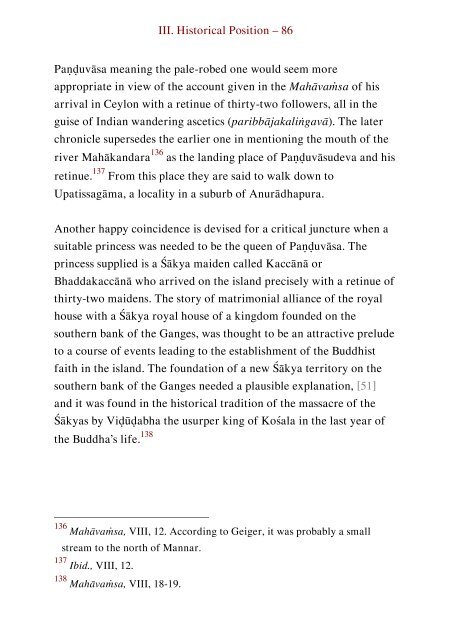On the Chronicles of Ceylon
A judicious appraisal of the various Chronicles that were written in Sri Lanka, assessing their chronology, literary and historical character.
A judicious appraisal of the various Chronicles that were written in Sri Lanka, assessing their chronology, literary and historical character.
- No tags were found...
You also want an ePaper? Increase the reach of your titles
YUMPU automatically turns print PDFs into web optimized ePapers that Google loves.
III. Historical Position – 86<br />
Paṇḍuvāsa meaning <strong>the</strong> pale-robed one would seem more<br />
appropriate in view <strong>of</strong> <strong>the</strong> account given in <strong>the</strong> Mahāvaṁsa <strong>of</strong> his<br />
arrival in <strong>Ceylon</strong> with a retinue <strong>of</strong> thirty-two followers, all in <strong>the</strong><br />
guise <strong>of</strong> Indian wandering ascetics (paribbājakaliṅgavā). The later<br />
chronicle supersedes <strong>the</strong> earlier one in mentioning <strong>the</strong> mouth <strong>of</strong> <strong>the</strong><br />
river Mahākandara 136 as <strong>the</strong> landing place <strong>of</strong> Paṇḍuvāsudeva and his<br />
retinue. 137 From this place <strong>the</strong>y are said to walk down to<br />
Upatissagāma, a locality in a suburb <strong>of</strong> Anurādhapura.<br />
Ano<strong>the</strong>r happy coincidence is devised for a critical juncture when a<br />
suitable princess was needed to be <strong>the</strong> queen <strong>of</strong> Paṇḍuvāsa. The<br />
princess supplied is a Śākya maiden called Kaccānā or<br />
Bhaddakaccānā who arrived on <strong>the</strong> island precisely with a retinue <strong>of</strong><br />
thirty-two maidens. The story <strong>of</strong> matrimonial alliance <strong>of</strong> <strong>the</strong> royal<br />
house with a Śākya royal house <strong>of</strong> a kingdom founded on <strong>the</strong><br />
sou<strong>the</strong>rn bank <strong>of</strong> <strong>the</strong> Ganges, was thought to be an attractive prelude<br />
to a course <strong>of</strong> events leading to <strong>the</strong> establishment <strong>of</strong> <strong>the</strong> Buddhist<br />
faith in <strong>the</strong> island. The foundation <strong>of</strong> a new Śākya territory on <strong>the</strong><br />
sou<strong>the</strong>rn bank <strong>of</strong> <strong>the</strong> Ganges needed a plausible explanation, [51]<br />
and it was found in <strong>the</strong> historical tradition <strong>of</strong> <strong>the</strong> massacre <strong>of</strong> <strong>the</strong><br />
Śākyas by Viḍūḍabha <strong>the</strong> usurper king <strong>of</strong> Kośala in <strong>the</strong> last year <strong>of</strong><br />
<strong>the</strong> Buddha’s life. 138<br />
136 Mahāvaṁsa, VIII, 12. According to Geiger, it was probably a small<br />
stream to <strong>the</strong> north <strong>of</strong> Mannar.<br />
137 Ibid., VIII, 12.<br />
138 Mahāvaṁsa, VIII, 18-19.


















